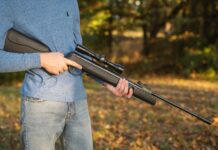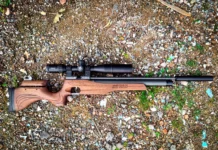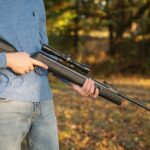Ask any turkey hunter, whether he’s a novice or a seasoned veteran, what his meaning of the perfect spring gobbler hunt is, and nine times out of 10 his tainted version will paint a picture sort of like this….
“Well, year before last I had seen this big ol’ bird in the field bottom fuzzed up with a bunch of hens. I mean you could near about see him him any time you wanted to venture across that pine ridge to where you could see the whole field. I figured that he has to be roosting somewhere around the creek as it fed into the beaverpond.
“So one night I told my wife that I had a good mind to go see if I could kill that gobbler the next morning. I didn’t do a real good job of figuring what time it was going to get light enough to see cause I got to the top of that pine ridge and the sky hadn’t even begun to break yet. So I was sitting there catching my breath when, dad burn, if that bird didn’t gobble just down the hill at the end of the field.
“I eased down the hill toward him about 50 more yards and set up by a big ol’ rotten pine treetop that had fallen during a bad ice storm that winter. I mean that bird was gobblin’ up a storm by now. And it was just starting to get light. I hadn’t heard a hen yet, but I gave him something to gobble about when I hit that box call with three or four little yelps. I think he forgot to take a breath cause he gobbled twice in a row. Directly he flew down and landed about 30 yards from me and went into a full strut. When he lifted his head, I let him have it with both barrels.”
Sound familiar? You bet it does! Unfortunately, these textbook encounters seem to happen only to the friends of mine who take a lackadaisical attitude into the woods with them in the spring. All my buddies who really get after the longbeards and study turkey hunting as if it were a college algebra class usually recant their first dual of the day as only a very rewarding, learning experience where the only student was the hunter and the teacher happened to be a wily gobbler that left class early with a bunch of his girlfriends.
All of us turkey hunters have experienced the time when all of our heart and soul was involved in the hunt as we set up on a roosted bird at daylight, only to be totally discouraged in our calling and hunting abilities as Casanova merrily made his way through the forest with his harem, paying no attention to the deliberate approach, crafty setup and finely honed calling sequences. The rest of the morning just seemed to follow a time-tested ritual: a half-hearted march back toward the truck stopping only occasionally to vent our frustrations by making a weak stab at finding another turkey. “It’s getting too hot anyway, I think I’ll grab a biscuit and go fishing.”
It is at this very time of the day that the most successful turkey hunters, the ones that regularly fill their tags every year, have only begun to get excited about the day’s hunt.
Why? The more we learn about the behavior patterns of the wild turkey during the spring, through harvest data, radio telemetry studies of gobblers and just plain old hunting experience, the more we find that the absolute best time to kill a gobbler is between the hours of 9 a.m. and 1 p.m.
Let’s take a look at what goes on in the turkey woods during this time of day and what makes it so productive. I visited with some experienced Georgia turkey hunters who have become quite good at calling in longbeards on a regular basis.
Being in the woods a lot during the entire year is not a problem for Mike Hunt, of West Point. Mike is a timber cruiser for Jones Woodyard in LaGrange and is constantly on the go around a several-county area as he cruises, marks and bids on tracks of timber. “Big Mike” became well-known in central Georgia for his deer hunting and fishing abilities, but during the last five years, he has enjoyed his share of success chasing gobblers. What is Mike’s favorite time of day to kill a bird? Just ask him.
“I have had by far most of my luck during my lunch break. I am at an advantage over most folks because come lunchtime I am usually real close to a piece of property that I have permission to turkey hunt on. I have to be at the woodyard most mornings at 8 a.m., so my early morning hunting before work is very short. I don’t usually have a problem knowing where to go to hear a bird on the roost at daylight but almost always he has hens with him early on, especially during April. So what I like to do is set up on him as normal, and even if he doesn’t come my way, I’ll get a fix on which way he’s headed. If I am around that area two to five hours later, I’ll slip in quietly and hit him with some excited cutts from my box call.
Mike’s strategies have been formulated through a lot of trial and error, like giving up on a bird and not trying him until the following day. His new-found tactics for success are simple. Give the bird time to court his hens and eventually they’ll leave him for their nests. The lovesick tom is content a lot of times to strut in his home range waiting for the hens to return later in the day.
“When I first started turkey hunting and knew very little about turkeys and their habits, especially gobblers, I only hunted at daybreak. Eventually I killed a few birds but most mornings I just couldn’t compete with all the hens. Now, I would say that if I had to choose one particular time of day that I was allowed to go into the woods after a longbeard, there’s no doubt it would be during the middle of the day.”
Laughing, Mike added, “I’m not a world-championship caller by any means, but I’ll tell you, a lonely gobbler can make a good caller out of me.”
Mike has also seen the sport of turkey hunting grow at a very fast pace. Naturally, he sees the disadvantage of having to compete with other hunters now more than ever for a good turkey, but with his midday tactics, Mike has found a way to take advantage of the early morning pressure.
“I honestly feel that with your turkey populations getting hunted harder and harder every year, and the vast majority of the hunting pressure taking place during the first three hours of daylight, their instincts are beginning to tell them that responding to the call of a hen first thing in the morning can be risky business. But on the flip side, some aggressive calling on up in the day when most hunters have gone home can bring in a gobbler when nothing else will. The biggest turkey I have ever called in for someone was for a fellow from Florida. I had fooled with this particular bird for a few days early in the morning, then I took this gentleman one day and he killed him at about 11:15 a.m. The old gobbler came strutting in very cautiously. His spur lengths were 1 1/2 inches and 1 3/8 inches.
Don Jones, of Marietta, spends most of his time in the turkey woods in McDuffie, Hancock, Taliaferro and Wilkes counties. These areas of the state have long been known to provide many hunters a rush on any given spring morning, but they also get plenty of hunting pressure, especially the past couple of seasons. Don, like Mike, knows the rewards of waiting out a gobbler until the middle of the day.
Being an excellent bowhunter with a Pope & Young deer to his credit, Don is an avid outdoorsman who just enjoys being in the woods. Staying in the woods from daylight until well into the afternoon is not uncommon for Don during the turkey season, and consequently, much of his success comes during what he calls his “flash hunts.”
“A flash hunt is when I’m calling aggressively one moment and the next moment I’ve got a gobbler on the ground,” said Don.
He describes his midday tactic as “prospecting.” Unlike a lot of experienced turkey hunters who rely on several different types of calls during a day’s hunt, Don travels very lightly in anticipation of covering a lot of ground on a routine hunt, and he depends almost exclusively on mouth diaphragms.
“Like any other turkey hunter, I’m waiting for the redbirds to wake up while waiting for that first gobble. If I’m not able to set up on a gobbling turkey early on, I start covering as much ground as possible. I stay mainly on top of the ridge and call down into the bottoms with a lot of excited cutting calls. I won’t usually get real serious about locating a receptive tom until after the sun has had a chance to get on up in the sky,” said Don.
“The reason I don’t call real heavy early on is I feel the chances of calling a longbeard away from his harem of hens is small, and I feel like I’m just educating the birds to my style of calling.”
This point is to be taken seriously. Since turkeys are birds with very strong social ties, meaning they don’t like to hang out alone except when hens nest, it is not a gobbler’s first choice to leave the company of other turkeys early in the morning.
The established dominance order a group of gobblers plays a key role in why midday hunting can be very successful. With turkeys roosting every night in groups, whether they’re large or small groups, there is a series of events that usually take place just after daybreak during the breeding season. They turkeys fly down and the dominant toms commence to strutting and courting the hens. During this time, the subordinate gobblers (usually 2-year-old birds) will hang around the action just to watch what is going on. Sometimes they can even get away with strutting, as long as it is outside the comfort zone of the boss tom. Any effort to get too close to the hens is met with some resistance. This continues for the first hour or two after fly-down time. Eventually, these subordinate, or satellite, gobblers will have worked themselves up in a frenzy and stray off looking for some action. It is these birds that can provide, in Don’s words, a flash hunt. Also, after a little longer length of time, the dominant gobbler is given the cold-shoulder treatment by his hens as they leave him to go to their nests, making him just vulnerable enough on up in the middle of the day to come in to some excited cutting calls of a hen.
Don ends up with this piece of advice, “I try to cover as much ground as possible, cutting loudly and often to get a response. The instant that I feel like the gobbler has begun to make his way toward my calling, I will cut back considerably on the volume and frequency of my calling. This is also a good time to begin scratching in the leaves to sound like a hen is feeding. I have killed some birds by only scratching after he answered my call and was headed my way.”
With turkey season nearly two weeks old, there is a good chance that gobblers in your neck of the woods have heard their share of calling early in the morning. By giving midday hunting a try, you can increase your odds by calling to birds when they don’t normally hear a lot of excited hen talk, catching a tom whose harem of hens has given him the slip, or maybe coaxing a satellite gobbler to within gun range.











































